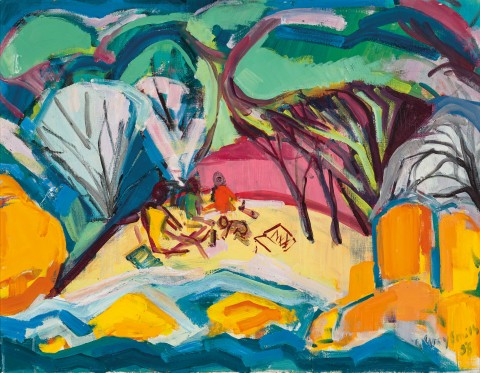BUNKER BAY, 1958
GUY GREY-SMITH
oil on canvas
51.5 x 67.0 cm
signed and dated lower right: G Grey Smith/58
Gallery 52, Perth
Private collection, Perth, acquired from the above on 16 March 1982
Thence by descent
Private collection, Sydney
Gallery 52, Perth, 1982
Bunker Bay is a favourite and secluded destination for holiday makers in Western Australia. Located 260 kilometres south of Perth, it is the last beach before Cape Naturaliste, at the western edge of Geographe Bay. Now braced by resorts and expensive homes, it was a pristine experience in the 1950s when Guy Grey-Smith painted this scene of the iridescent waters lapping the sands, anchored at either end by jagged rocks. It is possible that the artist visited the area for holidays with his own parents in the 1920s and 1930s, but he was now accompanied by his own family, and it is likely that the picnic group on the shore includes his wife and children. Distinctively, Grey-Smith has chosen to paint the scene from a small boat off-shore, a viewpoint which emphasises the quietude of the scene.
Bunker Bay, 1958, is one of a number of his paintings of the locale and sits at the mid-point of his development from a post-impressionist technique to his mature ‘slab form’ paintings from 1960 onwards. Grey-Smith first studied art as a convalescent former-prisoner of war at a sanitorium in southern England where he was treated for tuberculosis in 1944. He then trained for two years at the Chelsea School of Arts before returning to Western Australia in late 1947, visiting the forests of Fontainebleau en route in homage to his hero Cézanne. In 1952, he painted his first view of Bunker Bay (untraced) and the following year, he and his artist-wife Helen returned to London where he studied fresco techniques. Whilst there, he was mesmerised by an exhibition of the high-colour works of the French Fauves and his subsequent paintings exhibit his attempts to unite these disparate influences. For Bunker Bay, Winter, 1956 (private collection), Grey-Smith stood at the eastern edge and fills the scene with radiant colour – jarring in its contrast – contained within bold outlines, set against solid patches of pigment, indicative of similar results achieved consecutively in his frescos. For the painting on offer here, a similar approach is present but there is also greater fragmentation as he allows his brush to dictate the passage. His treatment of the tree canopies as self-contained entities is distinctly his own and can be seen in works as early as Dongara Flats, 1950 (Edith Cowan University) and Jarrahs, 1953 (Art Gallery of Western Australia). The contrasting cadmium yellow of the boulders in this lot illuminates the foreground and gives the sense of a sun-drenched whole, indicating that it was the summer school holidays when the journey was undertaken.
Although this painting was not exhibited during the artist’s lifetime, it was painted in a pivotal period for the artist, with his major work Gascoigne River Country purchased that year by the Art Gallery of New South Wales.
ANDREW GAYNOR
